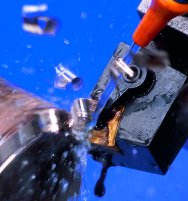|
Machining performance characteristics for coolants and lubricants are the key factors for proper selection…but the issues of safety and disposal have become equally important.
That depends on a variety of factors including:
These factors are all pertinent to making an informed cutting fluid selection. However, to provide a good starting point, manufacturers of cutting fluids have basically set up groupings that divide workpiece materials into three distinct categories:
Fluid Classifications
Semi-Synthetics - These consist of natural and synthetic emulsifiers, small oil droplets and clear emulsions. These offer good corrosion protection, lubrication and tolerance to contamination with better stability and sump life than soluble oil cutting fluids. They work with both ferrous and non-ferrous materials and help maintain a clean work environment. Synthetics – These are oil-free solutions of polymers and other organic and inorganic materials mixed with water. Because there is no oil, they have extremely long life. They run extremely clean and are very compatible with hard water and resist foaming. They work well at higher speeds and particularly on ferrous materials. The only limitation is that, in some situations, there may be some buildup on certain areas of the machine and staining is possible on non-ferrous materials. Soluble Oils – These consist of oil with emulsifiers that allow the oil to disperse in water. They provide heavy-duty lubricity in a wide range of applications. They are particularly suited for use in deep hole or gun-drilling applications on non-ferrous materials. A fourth classification includes what are called Specialty Fluids, Cleaners and Additives. These are basically lubricity enhancers, tapping compounds, fingerprint neutralizers, cleaners, and additives. In some cases, they can help prevent corrosion and provide a solid lubricant between the chip and the cutting tool. A specialty fluid can be applied either to the cutting fluid mix or, in its undiluted form, directly onto the workpiece before or during the machining operation. Troubleshooting A variety of problems or situations can occur with respect to cutting fluid performance, biostable characteristics, storage or mixing that require certain actions to be taken or in some cases the fluid to be completely changed. (Please see the Troubleshooting Chart A and Troubleshooting Chart B outlining some of the more common problems, causes, and solutions.) Cutting Fluid Care & Handling As with all cutting fluids, proper care and handling involves several important factors, which include storage, mixing, bacteria control, tramp oil control, application to the cutting zone, and proper disposal. These include situations as they relate to: Storage
Mixing Water-Soluble Concentrates:
Note: It is very important to measure the concentration after mixing. This can be accomplished by using a reftractomer, drop kits or sending in a sample to a test facility. All cutting fluid manufacturers provide the user with a concentration ratio for each fluid that can be checked with a refractometer. Remember, a refractomer reading and a concentration are different. If a fluid is mixed at a 21:1 ratio you will have a 5% dilution. However, the refractomer reading would not read 5% because there are normally other additives in the mixture. Water Hardness
Bacteria Control
Control of Tramp Oil
Debris and Dirt
Delivery to the Cutting Zone
Cutting fluid manufacturers can only suggest how to care and maintain coolants. What works in one plant will not always work in another. The end-user must also realize that manufacturers can only institute certain controls on the chemistry of a coolant. The single most important factor influencing a coolant is the condition in which it is used. Recycling Metalworking Fluids Many manufacturing operations today are finding it advantageous and cost-effective to clean up and re-use cutting fluids by either mechanical or filtration units. Systems can be set up to mechanically break out tramp oils from the coolant simply by letting them set still for a period of time. Another process involves the use of a coalescing unit that mechanically extends the surface area of the used coolant to also break out tramp oils. Other methods involve the use of various filtration systems. Conclusion Selecting, operating and maintaining good cutting fluids is a dynamic of manufacturing that requires constant updating in the latest techniques, product developments, current industrial trends and government regulations. Most fluid manufacturers provide training to keep customers informed. Valenite Valcool - September 2002 |
 Ninety-seven percent of the energy consumed in metalcutting is converted into heat. This heat can damage both the cutting tool and the work piece if the right kind of cooling doesn’t take place at the cutting edge. An overheated tool loses its hardness, which shortens its tool life and an overheated workpiece can lose its dimensional integrity. The solution is to continuously cool the tool and workpiece at the cutting edge. So what’s the best way to do it?
Ninety-seven percent of the energy consumed in metalcutting is converted into heat. This heat can damage both the cutting tool and the work piece if the right kind of cooling doesn’t take place at the cutting edge. An overheated tool loses its hardness, which shortens its tool life and an overheated workpiece can lose its dimensional integrity. The solution is to continuously cool the tool and workpiece at the cutting edge. So what’s the best way to do it? There are three basic classifications of cutting fluids that can be applied for each of these material categories. Depending on the specifics of the application, any one of the three cutting fluids could be used successfully. These include:
There are three basic classifications of cutting fluids that can be applied for each of these material categories. Depending on the specifics of the application, any one of the three cutting fluids could be used successfully. These include: